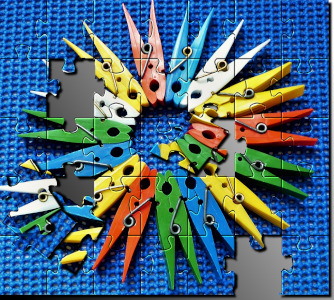
Speed puzzling relies heavily on pattern recognition techniques as a fundamental strategy to complete a jigsaw puzzle rapidly and efficiently. While it sounds all scientific, when it comes to completing a jigsaw puzzle faster, it’s important to realize you need advanced tips and techniques to complete a jigsaw fast.
Pattern Recognition Techniques Build Speed
As a speed puzzling enthusiast, I could see how some people shrug off the idea of pattern recognition techniques. I mean after all, it sounds very formal and it sort of draws away from the idea of a fun moment. However, it’s all about how you look at jigsaw puzzles (and what you do to build your techniques for times).
Table of Contents
Think about pattern recognition techniques as a tool that makes your time shorter. It’s also a tool that people use in other sports and in business. You find yourself identifying the object in a way that’s critical to the situation and that’s what makes this so important. One element that walks hand-in-hand with recognition is avoiding playing a tunnel vision during a competition.
Here’s a breakdown of why pattern recognition is crucial in the context of speed puzzling:
Rapid Identification of Piece Characteristics.
Quick Assessment is the first step in pattern recognition techniques. Speed puzzlers need to swiftly assess a large number of puzzle pieces. Pattern recognition allows them to identify distinct characteristics, such as colors, shapes, and patterns, at a glance. This quick assessment accelerates the process of selecting and connecting pieces.
Efficient Grouping of Similar Pieces.
Streamlining Sorting is what we all do, but this technique streamlines the process. Pattern recognition enables players to efficiently group pieces with similar features. Whether it’s sorting by color, edge characteristics, or specific image details, this grouping streamlines the search for matching pieces and minimizes the time spent scanning through the puzzle.
Simultaneous Handling of Multiple Sections.
Multitasking advantage is a technique we all have, but it becomes a valuable skill when we practice. Recognizing patterns allows speed puzzlers to work on multiple sections of the puzzle simultaneously. By identifying patterns in one area, they can strategically sort and connect pieces for other sections, maximizing efficiency and maintaining a continuous flow in their puzzle-solving process.
Identifying Anchor Points and Key Pieces in the Jigsaw.
Pattern recognition helps speed puzzlers identify anchor points and key pieces that play a crucial role in connecting different sections of the puzzle. Recognizing these critical connections allows players to prioritize specific pieces strategically, leading to a more cohesive and rapid assembly.
Reduction of Search Time for Certain Pieces.
As speed puzzlers become adept at recognizing patterns, the time spent searching for the right piece is significantly reduced. This reduction in hesitation allows for a smoother and more continuous puzzle-solving experience, contributing to faster completion times.
Enhancing Spatial Awareness with Improved Orientation
Pattern recognition enhances spatial awareness, enabling speed puzzlers to visualize how pieces fit together even before attempting to connect them. This intuitive understanding of spatial relationships contributes to a more accurate and rapid assembly.
Dynamic Adaptation to Puzzle Complexity.
Different puzzles present varying levels of complexity. Pattern recognition allows speed puzzlers to adapt dynamically to the intricacies of each puzzle, identifying and leveraging patterns unique to the specific image or design. This adaptability is crucial for navigating puzzles efficiently.
Prevention of Tunnel Vision by Expanding Perspective.
Pattern recognition helps speed puzzlers prevent tunnel vision by encouraging them to view the puzzle from multiple perspectives. Regularly rotating the puzzle and identifying patterns from different angles ensures a more comprehensive approach to solving complex jigsaws.
Techniques Help You Achieve Your Best Game
In summary, pattern recognition is the cornerstone of speed puzzling, providing players with the tools to quickly analyze, sort, and connect puzzle pieces. This strategic approach is part of my puzzle tips you need to consider for your next play. It’s essential when managing the complexity of jigsaw puzzles and achieving rapid completion times. As speed puzzlers develop and refine their pattern recognition skills, they unlock the key to mastering the dynamic and exhilarating world of competitive jigsaw puzzle solving.
